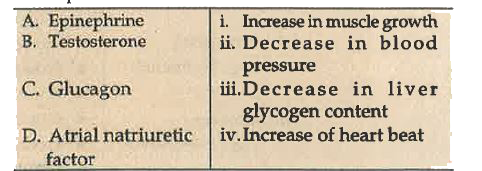In a bimolecular reaction, the steric factor P was experimentally determined to be 4.5. The correct options among the following is (are):
The value of frequecny factor predicted by Arrhenius equation is higher thatn that determined experimentally
The activation energy of the reaction is unaffected by the value of the steric factor
Since P=4.5 the reaction will not proceed unless an effective catalyst is added
Experimentally determined value of frequecny factor
The correct Answer is:B, D
To solve the question regarding the bimolecular reaction with a steric factor (P) of 4.5, we will analyze the implications of this value on the frequency factor and activation energy.
1. Understanding the Steric Factor (P):
- The steric factor (P) is a measure of the probability that a collision between reactant molecules will lead to a reaction. A value of P greater than 1 indicates that the actual frequency of effective collisions is higher than what would be expected based on simple collision theory.
2. Impact on Frequency Factor:
- The Arrhenius equation is given by:
k=Ae−EaRT
where k is the rate constant, A is the frequency factor, Ea is the activation energy, R is the gas constant, and T is the temperature in Kelvin.
- When P > 1, it suggests that the experimental frequency factor (A) is less than the calculated frequency factor based on the assumption of random collisions.
3. Activation Energy:
- The activation energy (E_a) is independent of the steric factor. This means that even though P is greater than 1, it does not affect the value of E_a.
4. Analyzing the Options:
- Since we know that:
- The activation energy is unaffected by the steric factor.
- The experimentally determined value of the frequency factor is greater than the calculated frequency factor.
- Therefore, we can conclude that:
- The statement regarding the frequency factor being higher than the predicted value is true.
- The statement about the activation energy being unaffected is also true.
5. Correct Options:
- Based on the analysis, the correct options are:
- Option 2: Activation energy of the reaction is unaffected.
- Option 4: Experimentally determined value of frequency factor is greater than calculated.
Summary of Correct Options:
- Option 2 and Option 4 are correct.
- The steric factor (P) is a measure of the probability that a collision between reactant molecules will lead to a reaction. A value of P greater than 1 indicates that the actual frequency of effective collisions is higher than what would be expected based on simple collision theory.
- The Arrhenius equation is given by:
k=Ae−EaRT
where k is the rate constant, A is the frequency factor, Ea is the activation energy, R is the gas constant, and T is the temperature in Kelvin.
- When P > 1, it suggests that the experimental frequency factor (A) is less than the calculated frequency factor based on the assumption of random collisions.
- The activation energy (E_a) is independent of the steric factor. This means that even though P is greater than 1, it does not affect the value of E_a.
- Since we know that:
- The activation energy is unaffected by the steric factor.
- The experimentally determined value of the frequency factor is greater than the calculated frequency factor.
- Therefore, we can conclude that:
- The statement regarding the frequency factor being higher than the predicted value is true.
- The statement about the activation energy being unaffected is also true.
- Based on the analysis, the correct options are:
- Option 2: Activation energy of the reaction is unaffected.
- Option 4: Experimentally determined value of frequency factor is greater than calculated.
- Option 2 and Option 4 are correct.
Topper's Solved these Questions
- BOOK - OP TANDONCHAPTER - CHEMICAL KINETICSEXERCISE - ASSERTION- REASON TYPE QUESTIONS14videos
CHEMICAL KINETICS
- BOOK - OP TANDONCHAPTER - CHEMICAL KINETICSEXERCISE - MATRIX MATCHING TYPE QUESTIONS11videos
CHEMICAL KINETICS
- BOOK - OP TANDONCHAPTER - CHEMICAL KINETICSEXERCISE - OBJECTIVE QUESTIONS (LEVEL-B) SET I48videos
CHEMICAL KINETICS
- BOOK - OP TANDONCHAPTER - CARBOXYLIC ACIDS AND THEIR DERIVATIVESEXERCISE - Integer4videos
CARBOXYLIC ACIDS AND THEIR DERIVATIVES
- BOOK - OP TANDONCHAPTER - Chemical Thermodynamics and ThermochemistryEXERCISE - Self Assessment (Integer type).3videos
Chemical Thermodynamics and Thermochemistry
Similar Questions
In a bimolecular reaction. The steric factor P was experimentally determined to be 4.5. the correct option(s) among the following is (are)
View SolutionIn a bimolecular reaction, the steric factor P was experimentally determined to be 4.5. The correct options among the following is (are):
View Solution
Knowledge Check
- Question 1 - Select One
The correct option among the following is:
AColloidal medicines are more effective because they have small surface area.BAddition of alum to water makes it unfit for drinking,Ccolloidal particles in lyophobic sols can be precipitated by electrophoresis.DBrownian motion in colloidal solution is fater if the viscosity of the solution is very high. - Question 2 - Select One
The correct option among the following is:
AColloidal particles in lyophobic sols can be precipitated by electrophoresis.BColloidal medicines are more effective because they have small surface area.CBrownian motion in colloidal solution is faster if the viscosity of the solution is very high.DAddition of alum to water makes it unfit for drinking - Question 3 - Select One
The correct option among the following is
AColloidal particles in lyophobic sols can be precipitated by electrophoresisBBrownian motion in colloidal solution is faster if the viscosity of the solution is very high.CColloidal medicines are more effective because they have small surface areaDAddition of alum of water makes it unfit for drinking.
Choose the correct option among the following.
 View Solution
View SolutionSelect the correct reaction among the following :
View SolutionCorrect options for the following reaction is/are
 View Solution
View SolutionChoose the correct answer among the following options:
 View Solution
View SolutionChoose the correct order among the following option.
View Solution

